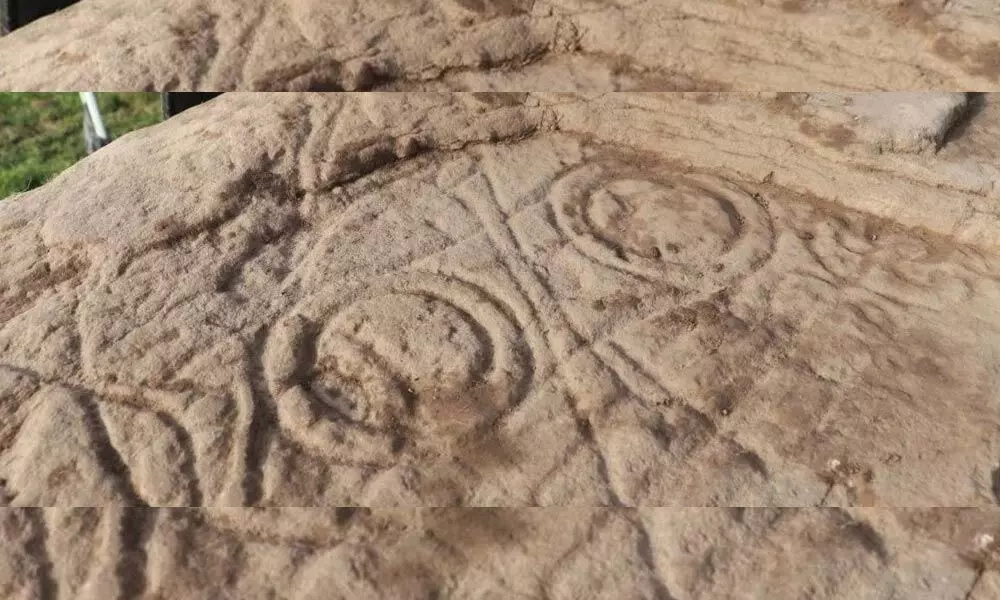Live
- Dr Singh’s integrity & services unparalleled
- Staying single in life can have economic, medical disadvantages
- Nimrat Kaur bookmarks chapters from 2024 as she gears up to welcome New Year
- Simple tips on how to select your bridal lehenga
- Gunvatta yatra to build awareness on NABL accreditation
- ‘Sanjha SHG Mela 2024’ evokes good response
- Land acquisition for Old City Metro picks up pace
- MP Eatala put off by state of govt hospital
- Hyderabad: Gift books, not bouquets, Governer urges people
- HYDRAA protected 12 lakes, 8 parks, says Commissioner
Just In
Archeologists Discovered Geometric Carvings In Scotland

Hans News Service | 24 March 2022 8:30 PM IST

x
Pictish symbols. (University of Aberdeen)
Highlights
- Archaeologists in Scotland experienced "real tears" after uncovering a stone covered with geometric designs created that the 'Picts'
- According to the experts, several of the carved symbols overlap, implying that they were carved at various times.
Archaeologists in Scotland experienced "real tears" after uncovering a stone covered with geometric designs created that the 'Picts' that is expected to be created by the region's indigenous population around 1,500 years ago.
During a geophysical investigation near Aberlemno, a community with Pictish roots, the crew discovered the 5.5-foot-long (1.7-meter) engraved stone.
Triple ovals, a comb and mirror, a crescent, and double discs are among the geometric designs on the stone that represent abstract Pictish symbols. According to the experts, several of the carved symbols overlap, implying that they were carved at various times.
According to Gordon Noble, excavation leader and professor of archaeology at the University of Aberdeen, the meaning of all the symbols is unknown, but the perfect assumption is that they are an identifying system representing Pictish names.
James O'Driscoll, an archaeologist at the University of Aberdeen in Scotland who assisted excavate the stone called it as a lifetime achievement.
The Latin word for painted, or "picti" were formidable people who inhabited in areas of what is now Scotland in ancient and mediaeval times. They are largely to blame for the Roman Empire's failure to conquer Scotland.
The recent discovery is one of just roughly 200 such stones that archaeologists are aware of. Aberlemno is also notable for its unusual standing stones, along with a slab that may portray scenes from the Battle of Nechtansmere, a Pictish triumph over the Anglo-Saxon kingdom of Northumbria in 685 CE that is linked to the founding of what would become Scotland.
Archaeologists were studying the area as part of the Comparative Kingship project, a five-year research of the early mediaeval kingdoms of northern Britain and Ireland, when they discovered the site in early 2020.
The researchers detected irregularities when moving imaging equipment across the grass, implying that the remains of a village lay underground.
The archaeologists dug a narrow pit to examine what was lying beneath their feet in order to learn more. They were astounded to discover the carved Pictish stone.
The team had wanted to excavate and investigate the stone right away, but COVID-19 lockdowns forced them to postpone their preparations. They were finally able to remove and analyse the stone after months of waiting, and the carvings were dated to the fifth or sixth century CE.
Carved Pictish stones are quite rare. Noble said in a statement that they are frequently dug up by farmers working fields or during road construction, but much of what accompanies them has already been altered by the time we get to analyse them.
He added that they find something like this during digging one small test pit is really astounding, and none of us could believe our good fortune.
They were able to "analyse and date the strata beneath it and obtain far more specific information without losing critical evidence" since the rock was found undamaged in the ground.
As per radiocarbon testing, the slab was eventually repurposed as a paver in a building dating to the 11th or 12th century and set alongside other pavers, some of which had Bronze Age rock art on them.

Next Story
More Stories
ADVERTISEMENT
© 2024 Hyderabad Media House Limited/The Hans India. All rights reserved. Powered by hocalwire.com






